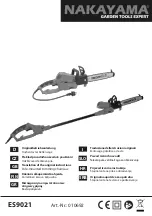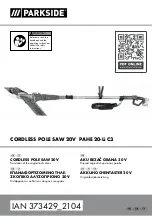
English
21
PRIOR TO OPERATION
1. Power
source
Ensure that the power source to be utilized conforms to the power requirements speci
fi
ed
on the product nameplate.
2. Power
switch
Ensure that the power switch is in the OFF position. If the plug is connected to a receptacle
while the power switch is in the ON position, the power tool will start operating immediately,
which could cause a serious accident.
3. Extension
cord
When the work area is removed from the power
source, use an extension cord of su
ffi
cient thickness
and rated capacity. The extension cord should be
kept as short as practicable.
4. Prepare a wooden workbench (
Fig. 2
)
Since the saw blade will extend beyond the lower
surface of the lumber, place the lumber on a
workbench when cutting. If a square block is utilized
as a workbench, select level ground to ensure it
is properly stabilized. An unstable workbench will
result in hazardous operation.
CAUTION
To avoid possible accident, always ensure that the portion of lumber remaining
after cutting is securely anchored or held in position.
ADJUSTING THE SAW PRIOR TO USE
1. Adjusting the cutting depth
As shown in
Fig. 3
, hold the handle with one hand while
loosening the knob with the other.
The cutting depth can be adjusted by moving the base to
the desired position. In such manner adjust the cutting
depth and then securely retighten the knob.
2. Adjusting the riving knife
Set the tool’s cutting depth to the minimum.
Loosen the hexagonal - socket bolt used to clamp
the riving knife, adjust the riving knife so that the
distance between the riving knife and the rim of
the blade is not more than 3 mm, and the rim
of the blade does not extend more than 3 mm
beyond the lowest edge of the riving knife (
Fig. 4
)
and securely retighten the bolt.
Lumber
Base
Saw blade
Workbench
Fig. 2
Fig. 3
Handle
Knob
Base
Riving knife
1 – 3 mm
1 – 3 mm
Hexagonal-
socket bolt
Fig. 4
000Book̲C7U3̲ChS.indb 21
000Book̲C7U3̲ChS.indb 21
2018/03/27 14:34:51
2018/03/27 14:34:51








































